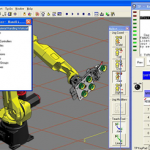Simulation & CAD-to-Path
Motion Controls Robotics uses a variety of robotic simulation software tools to help customers visualize systems and determine cycle times, cell layout and longevity estimations. Using 3D CAD, ROBOGUIDE® and Extend simulation software, we can prove out different concepts for your robotic cell or entire lines to ensure a return on investment, with very little up-front cost. Motion Controls Robotics uses FANUC’s ROBOGUIDE® family of offline robot simulation software products to emulate your robotic cell. FANUC robots are exactly modeled and operate on a Virtual Robot Controller, allowing the user to precisely simulate a robotic process in 3D virtual space or conduct feasibility studies for robotic applications – without the physical need and expense of prototype work cell setup.

